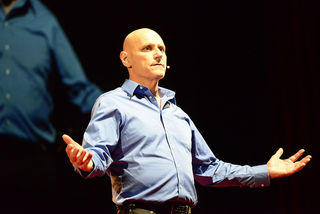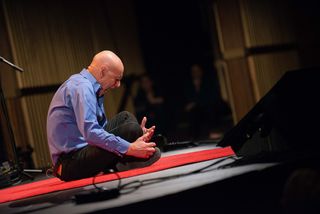Anxiety
What I Learned About Anxiety by Giving a Talk on Anxiety
Psychological flexibilty shows how love can turn pain into purpose
Posted February 23, 2016
For the last few years, this was the talk I most feared: standing in front of a 1,000 people doing a TED talk about my history of panic disorder, and exploring its relation to the domestic violence I saw in my home as a small boy.
Last month I gave that talk. (https://www.bit.ly/StevesFirstTED)
It was among the most difficult things I’ve ever done, and I learned something important.

First, some background. 34 years ago, at the height of a three year-long struggle with panic disorder, I sat on a brown and gold shag carpet at two in the morning and hit bottom. I saw no way out and I marked that moment by screaming a weird, breathy, nightmarish scream. Then, just a few silent minutes later, a door opened – and instead of finding a way out, I found a way in. My life took on a completely different character.
What I learned that night led me to dedicate my career to exploring the concept of psychological flexibility and to developing a form of treatment—Acceptance and Commitment Therapy (ACT)—to help teach it. You’d think a whole career’s worth of work would have made it easy for me to share this journey with the TED audience.
It was anything but. It was full of anxiety, but not just that. Sadness. Feeling overwhelmed.
Here is what I learned from it this experience.
1. Time does not heal all things, it just covers things up.
I was determined not just to tell a story. I wanted to revisit that very moment of hitting bottom – not by talking about it, but by going there.
I had not heard that scream nor made that strange sound in 34 years … but I could hear it in my mind. There was something almost sacred about it. It was the pivot point of my entire life.
I did not want to sully the moment by practicing it as one might a performance, so when practicing the TED talk, I skipped the scream. I would do that scream one more time in my life, and one more time only. I wanted the audience to feel what it is like for a human being to hit bottom, and to have nowhere to go.
It is one thing to plan that. It is another thing entirely to do that. As the time for the talk and that scream arrived I felt the horror of that moment looming over me like a death eater from Harry Potter. My churning insides told me in no uncertain terms about the raw pain of returning to my history of panic disorder, regardless of how many years had passed.

2. Underneath anxiety is something even harder, and it is not enough just to know what that something is.
About 10 minutes before I had to go backstage, I asked my wife if I could share a few private moments with her. “I think I see something important” I said. “It is not the anxiety of this talk that I’m afraid of.” She looked at me quizzically, since she had seen me anxiously preparing this talk for months. “It’s that I’m afraid I will just get up there and cry so hard I won’t be able to give the talk at all.” She hugged me tight. “Even that” she whispered “would be OK.”
In the TED talk I told the story of how that moment on the brown and gold shag carpet led me to a long-suppressed memory of hiding under the bed as a child while my parents fought violently in the other room, and deciding “I’m going to do something!” I had seen my older brother Greg, almost get hit when trying to defend my mother. That night, I wisely decided not to intervene, but to stay safely under the bed, and cry.
Now I was going to tell that story, fully and openly. Even when I rehearsed the talk alone, I cried almost every time I told this part of it. Looking out over 1,000 people who would soon be listening to me, I wondered if it was possible to visit the trauma and sadness of domestic violence and still give the talk I’d planned.
Before my wife and I parted company for me to head backstage I said softly to her “I think I have some work to do about that trauma.”
I know I do. I’ve long known that trauma lies underneath my anxiety. The entire TED talk was based on that. But it took this talk shaking me to my foundations to let me know in an emotional way (see insight #1 above!) that I have more work to do.
I don’t yet know how it will be done but my intention is to somehow walk inside that sadness with open arms, and to hug that traumatized little boy while I listen to what he has to say.
3. Turning toward pain and suffering in a loving way is a precondition to turning toward meaning and purpose.
The content of my TED talk is all about this, and in a parallel way, giving the talk itself was all about this! As I walked backstage, I opened my computer and made a few quick notes, just moments before I had the “Madonna mike” put on me. I did it in the hopes that I would carry these thoughts into the experience of giving the talk.
Here is part what I wrote down, which I hope will explain what I mean:
This is not for you, this is for others. Let your story go out into the world. It is OK if great sadness is there. Focus on the suffering in the room and in the world; be present; bring what you have to give, and give it.
And overall, I did carry these thoughts into the talk. I touched pain and suffering on purpose – the terror of a 33 year-old man who was losing his ability to function; the sadness and horror of a little boy watching his parents do the same – and that in itself was meaningful.
Turning toward pain and suffering as an act of loving-kindness empowers bringing love and meaning into the world. Promoting that kind of psychological flexibility through Acceptance and Commitment Therapy (ACT) is my life’s work. ACT is one of the most researched forms of mindfulness and acceptance-based psychotherapy, with nearly 200 randomized trials and hundreds of studies of other kinds. We know there is scientific substance in the work, and you would think 34 years would be enough time to make re-visiting that moment easy.
It wasn’t.
But in discovering this, I relearned the basic lesson of that night on the carpet 34 years ago. Anxiety is not our enemy. What we know about suffering helps us see the suffering that is in others; taking the time to be present with ourselves allows us to focus on what we have to give, and to do our best to give it.




